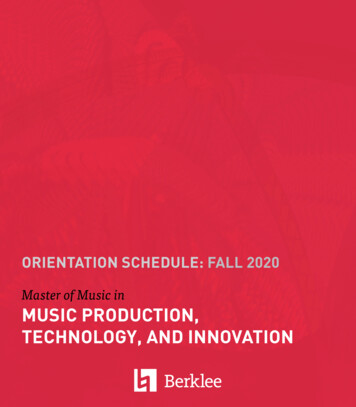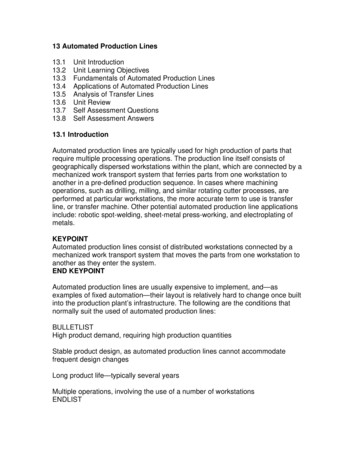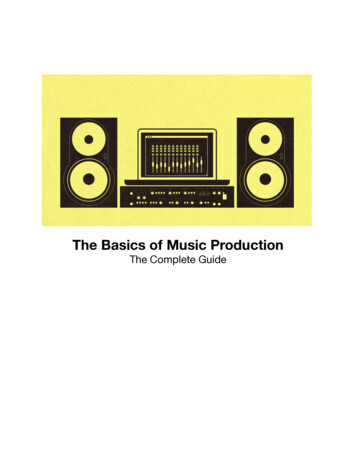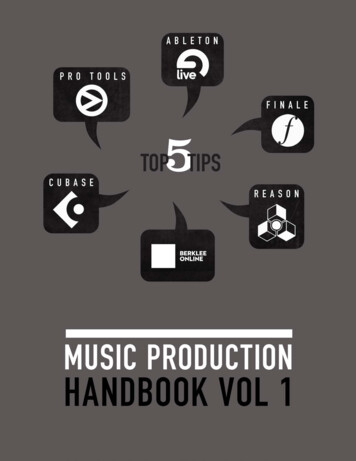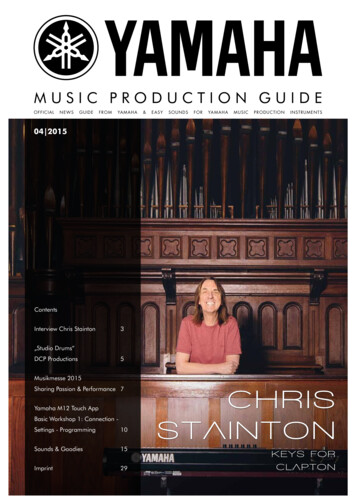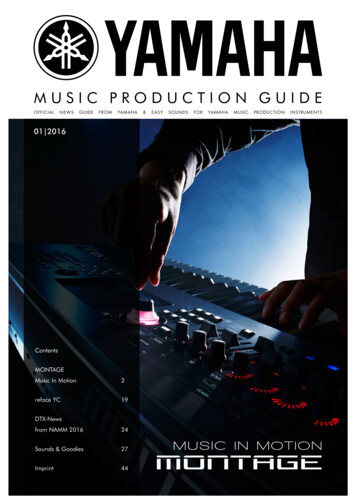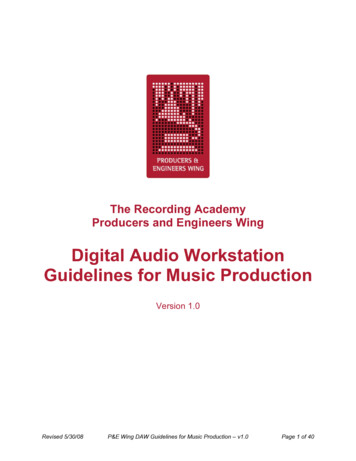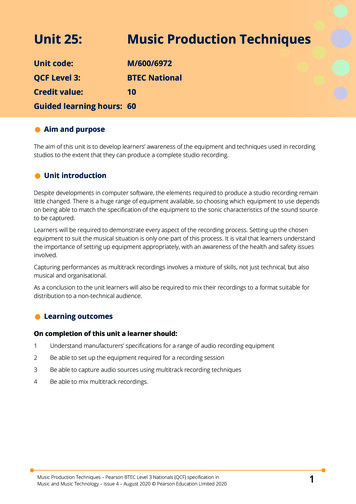
Transcription
Unit 25:Music Production TechniquesUnit code:M/600/6972QCF Level 3:BTEC NationalCredit value:10Guided learning hours: 60Aim and purposeThe aim of this unit is to develop learners’ awareness of the equipment and techniques used in recordingstudios to the extent that they can produce a complete studio recording.Unit introductionDespite developments in computer software, the elements required to produce a studio recording remainlittle changed. There is a huge range of equipment available, so choosing which equipment to use dependson being able to match the specification of the equipment to the sonic characteristics of the sound sourceto be captured.Learners will be required to demonstrate every aspect of the recording process. Setting up the chosenequipment to suit the musical situation is only one part of this process. It is vital that learners understandthe importance of setting up equipment appropriately, with an awareness of the health and safety issuesinvolved.Capturing performances as multitrack recordings involves a mixture of skills, not just technical, but alsomusical and organisational.As a conclusion to the unit learners will also be required to mix their recordings to a format suitable fordistribution to a non-technical audience.Learning outcomesOn completion of this unit a learner should:1Understand manufacturers’ specifications for a range of audio recording equipment2Be able to set up the equipment required for a recording session3Be able to capture audio sources using multitrack recording techniques4Be able to mix multitrack recordings.Music Production Techniques – Pearson BTEC Level 3 Nationals (QCF) specification inMusic and Music Technology – Issue 4 – August 2020 Pearson Education Limited 20201
Unit content1Understand manufacturers’ specifications for a range of audio recording equipmentMicrophones: polar pattern; frequency response; sensitivity; type eg dynamic, condenser, ribbon,boundaryMixing desks: routing; channels; busses; auxiliaries; groups; inputs; outputs; facilities eg EQ, monitoringRecording devices: tracks; inputs; outputs; format eg stand alone, computer-based digital audioworkstation, audio interface; specification eg protocol, bit depth, sample rate, noise figuresMonitoring: eg nearfield, midfield, full range, frequency response, two-way, three-way, passive, active,power rating2Be able to set up the equipment required for a recording sessionMicrophone techniques: eg spot mic’ing, close mic’ing, ambient mic’ing, spaced pair, coincident pair,middle and sides, DIRouting: eg patchbays, input gain settings, gain structure, busses and groups, recording device settings,recording level, talkback, foldback, dynamic control3Be able to capture audio sources using multitrack recording techniquesAudio sources: eg drum kit, guitar, bass, piano, woodwind and brass instruments, orchestral instruments,single and multiple voicesTechnical issues: eg talkback, fold back, click track, managing takes, data storage/archiving, track laying,overdubbingOrganisational issues: eg tuning instruments, working with musicians, communication, organisation,timekeeping, keeping records, preparation, clearing up4Be able to mix multitrack recordingsVolume: eg balancing levels, fadeout, automation, headroom, output levelPan/balance: eg using the stereo field, phase issues, idiomatic treatmentDynamic control: eg noise gates, compressors, side chains, limiters, expanders; dynamic rangeEqualisation: creative EQ; remedial EQEffects: connection eg inserts, sends; type eg time domain effects, dynamic processors; specific effectseg reverb, delay, chorus, flanger; distortion effects eg guitar amp simulation, overdrive, bitcrusher;ambient controlEditing: eg comping, top and tail edits, trimming, normalising, fadesBouncing down: eg file types, real-time, off-line, start and end points2Music Production Techniques – Pearson BTEC Level 3 Nationals (QCF) specification inMusic and Music Technology – Issue 4 – August 2020 Pearson Education Limited 2020
Assessment and grading criteriaIn order to pass this unit, the evidence that the learner presents for assessment needs to demonstrate thatthey can meet all the learning outcomes for the unit. The assessment criteria for a pass grade describe thelevel of achievement required to pass this unit.Assessment and grading criteriaTo achieve a pass grade theevidence must show that thelearner is able to:To achieve a merit grade theevidence must show that, inaddition to the pass criteria,the learner is able to:To achieve a distinction gradethe evidence must show that,in addition to the pass andmerit criteria, the learner isable to:P1explain manufacturers’specifications for a range ofaudio recording equipment[IE, SM]M1illustrate manufacturers’specifications for a range ofaudio recording equipmentD1analyse manufacturers’specifications for a range ofaudio recording equipmentP2set up the equipmentrequired for a recordingsession competently withlimited tutor support[IE, CT, RL, SM, EP, TW]M2set up the equipmentrequired for a recordingsession confidently withtotal independenceD2set up the equipmentrequired for a recordingsession demonstratingmastery of the processesinvolvedP3capture audio sourcesusing multitrack recordingtechniques[IE, CT, RL, SM, EP, TW]M3capture audio sourcesusing multitrack recordingtechniques competentlyD3capture audio sourcesusing multitrack recordingtechniques with confidenceand flairP4mix multitrack recordings.[IE, CT, RL, SM]M4mix multitrack recordingscompetently.D4mix multitrack recordingswith confidence and flair.PLTS: This summary references where applicable, in the square brackets, the elements of the personal,learning and thinking skills applicable in the pass criteria. It identifies opportunities for learners todemonstrate effective application of the referenced elements of the skills.KeyIE – independent enquirersRL – reflective learnersSM – self-managersCT – creative thinkersTW – team workersEP – effective participatorsMusic Production Techniques – Pearson BTEC Level 3 Nationals (QCF) specification inMusic and Music Technology – Issue 4 – August 2020 Pearson Education Limited 20203
Essential guidance for tutorsDeliveryMost, if not all, of this unit should be delivered through practical workshops. Learners will need to accessthe technology required to conduct multitrack recording sessions, including microphones, soundgenerating equipment and musical instruments, and recording and mixing equipment, and appropriatespaces that allow effective decisions to be made on equipment choice and setup based on critical listening.Ideally, learners should have access to a wide range of equipment and be encouraged to experiment withdifferent recording equipment and techniques in order to discover which methods are most effective.Learners should be engaged in the process of creating music product from an early stage of the unitdelivery, with the required theoretical and contextual elements of the unit added as necessary. The theorybehind recording would be best delivered in a practical way. Learners must be encouraged to adopt aprofessional time-conscious approach to the recording process from the beginning.Resources will need to be carefully managed to allow learners enough session time to create the evidencerequired for each learning outcome. Time demands of individual projects will need to be carefully assessedbefore allowing production to proceed, as class time is likely to focus on team activity, with learnersrequired to cycle through a variety of roles, including producer, engineer, assistant, performer, etc asnecessary. Learners will need access to resources outside of timetabled contact time to enable them tocomplete the practical work necessary. Potentially This unit can be delivered alongside other units, whoseoutcomes require evidence to be captured in the recording studio, time for this must be allowed in additionto that allowed for this unit.Mixing can take place in a computer-based environment as a classroom-based activity but learners must bemade aware of the limitations of mixing on headphones and be encouraged to check their mixes on variousreference systems as often as possible. This may add to the time where learners require access to studioresources outside of contact time.4Music Production Techniques – Pearson BTEC Level 3 Nationals (QCF) specification inMusic and Music Technology – Issue 4 – August 2020 Pearson Education Limited 2020
Outline learning planThe outline learning plan has been included in this unit as guidance and can be used in conjunction withthe programme of suggested assignments.The outline learning plan demonstrates one way in planning the delivery and assessment of this unit.Topic and suggested assignments/activities and/assessmentIntroduction to the programme and structure of the programme of learning.Understanding manufacturers’ specifications for recording equipment – learning outcome 1; theory classeson:ztypes of audio equipmentzhow the performance of audio equipment is measuredzmanufacturers’ specifications.Assignment 1: The Specification of Recording Equipment – P1, M1, D1zLearners to prepare presentations.zLearners to give presentations.Setting up recording equipment – learning outcome 2; tutor-led workshops to cover:zsetting up microphoneszsetting up input gainzsetting up the routing required for recordingzsetting up foldback mixes.Capturing a multitrack recording – learning outcome 3; tutor-led workshops to cover:zcapturing audio to the recording devicezoverdubbingzpunching inzmanaging recording sessions.Assignment 2: Setting up and Capturing a Multitrack Recording – P2, M2, D2, P3, M3, D3zLearner practical work/resource-based learning.zCreating recording logs.Mixing the multitrack recordings to stereo – learning outcome 4; tutor-led workshops to cover:zmixing techniqueszediting techniqueszbouncing down.Assignment 3: Stereo Mix – P4, M4, D4zLearner practical work/resource-based learning.zCreating mixing log.Music Production Techniques – Pearson BTEC Level 3 Nationals (QCF) specification inMusic and Music Technology – Issue 4 – August 2020 Pearson Education Limited 20205
AssessmentThis unit is about learners’ understanding of recording equipment and their ability to use it to createmusically acceptable products, and also about their understanding and management of the entire studioproduction process.Learning outcome 1 is most easily evidenced through a written report, but as an alternative this evidencecould be collected by directed questioning in a practical context. If so, this must be carefully controlled inorder to capture the full range of technical information required, and allowing for the group situation inwhich much of the practical work will be carried out.To achieve a pass for learning outcome 1 learners will provide explanations of the terminology foundin manufacturers’ specifications as outlined in the unit content. At merit level, learners will elaboratetheir explanations with reference to appropriate examples. At distinction level, learners will analyse theimportance of each aspect of terminology in relation to the recording process and the application ofgiven examples in the recording process based on a specification. It is appropriate to compare differentexamples in terms of suitability at this level.To create evidence for learning outcome 2, learners should be demonstrating both microphone techniquesand routing as indicated in the unit content. Because of resourcing issues it is likely that learners will spendsignificant amounts of time working independently and the style of classroom management associatedwith this unit, and so for this learning outcome it is essential that observations are carried out rigorouslyto support evidence of higher grading. Learners should be encouraged to keep clear records of theiractivities, perhaps using pro forma documentation, as it will be difficult to return to the required activities ifassessment opportunities are missed.To achieve P2, learners will successfully setup and configure microphones and recording equipment fora multitrack recording session, but they may require some tutor intervention. Learners who require notutor intervention will be working at merit level, and this will be evidenced by tutor observation of learnerdemonstration. Distinction level learners will show that they have a clear understanding of all of theprocesses involved, in addition to the requirements for P2 and M2.It is likely that capturing audio takes place as part of the same recording sessions. That is, the evidence forlearning outcome 3 will be created during the same practical workshop sessions as for learning outcome 2.Learning outcome 3 requires the capture of audio to a multitrack recording device, and for P3 learners willsubmit the unmixed audio, perhaps as a sequencer project/session if a software digital audio workstation isbeing used. For M3, the tutor observation report or video evidence will show the correct use of a range ofappropriate skills. This could be augmented by the written evidence submitted by learners (for example therecording log, tracksheets, etc). To achieve D3, the evidence will show that learners have mastered the skillsrequired (technical and organisational) to the extent that their ability to track audio in recording sessionsis not inhibited by technical limitation. Skills such as capturing takes and dropping in, and the use of themonitoring section will have been used in such a way that the results show creativity and imagination.Learning outcome 4 will be evidenced by the submission of the multitrack recordings (to suitable stereoformat) an accompanying mixing log may also prove useful in accounting for the process. Learners whosesubmissions show the use of mixing skills will achieve P4. Where mixing skills have been applied correctlyand in such a way as to enhance the original recordings, this will evidence M4. For D4, the evidence willshow that learners ha
Unit 25: Music Production Techniques Unit code: M/600/6972 QCF Level 3: BTEC National Credit value: 10 Guided learning hours: 60 Aim and purpose The aim of this unit is to develop learners’ awareness of the equipment and techniques used in recording studios to the extent that they can produce a complete studio recording. Unit introduction Despite developments in computer software, the .
